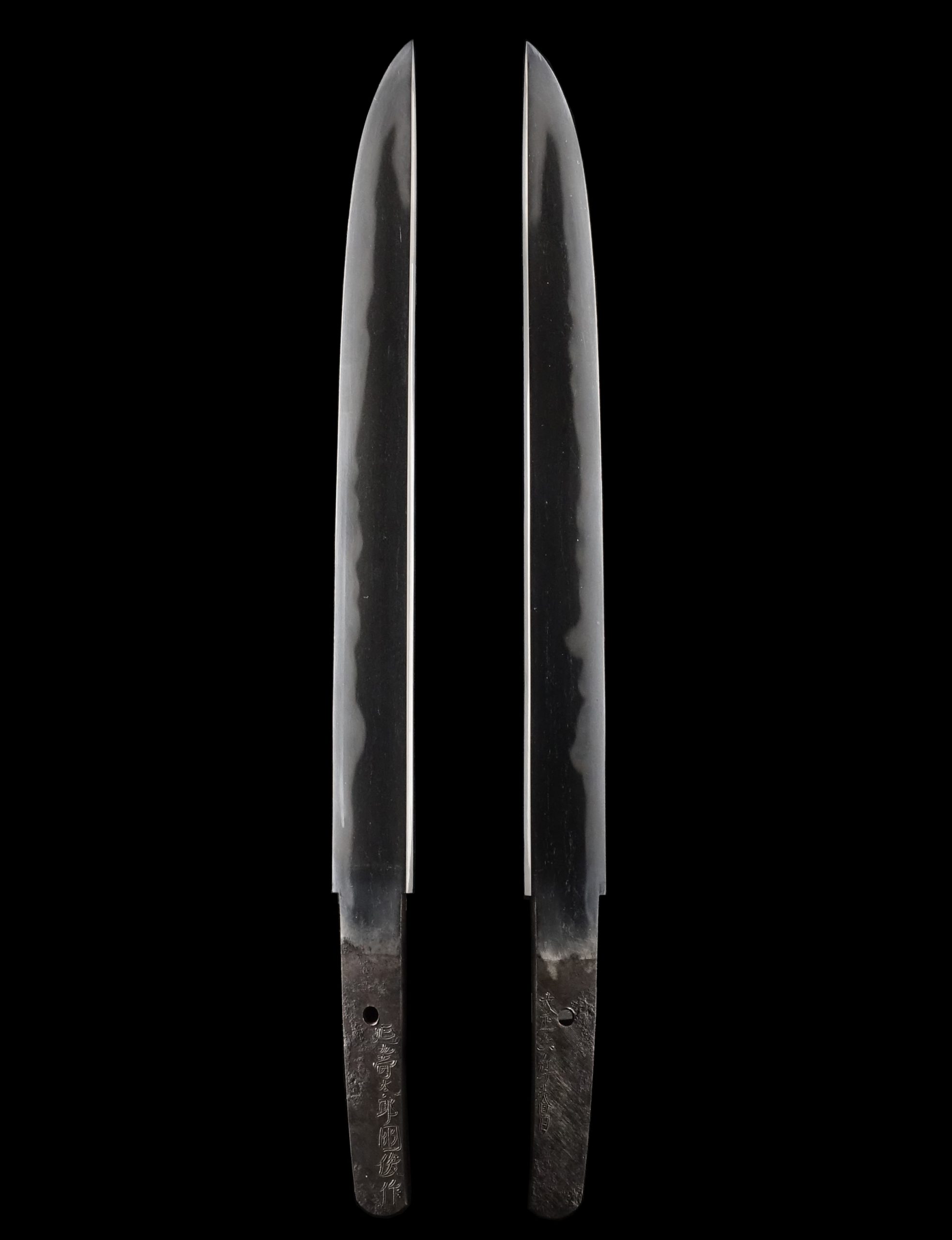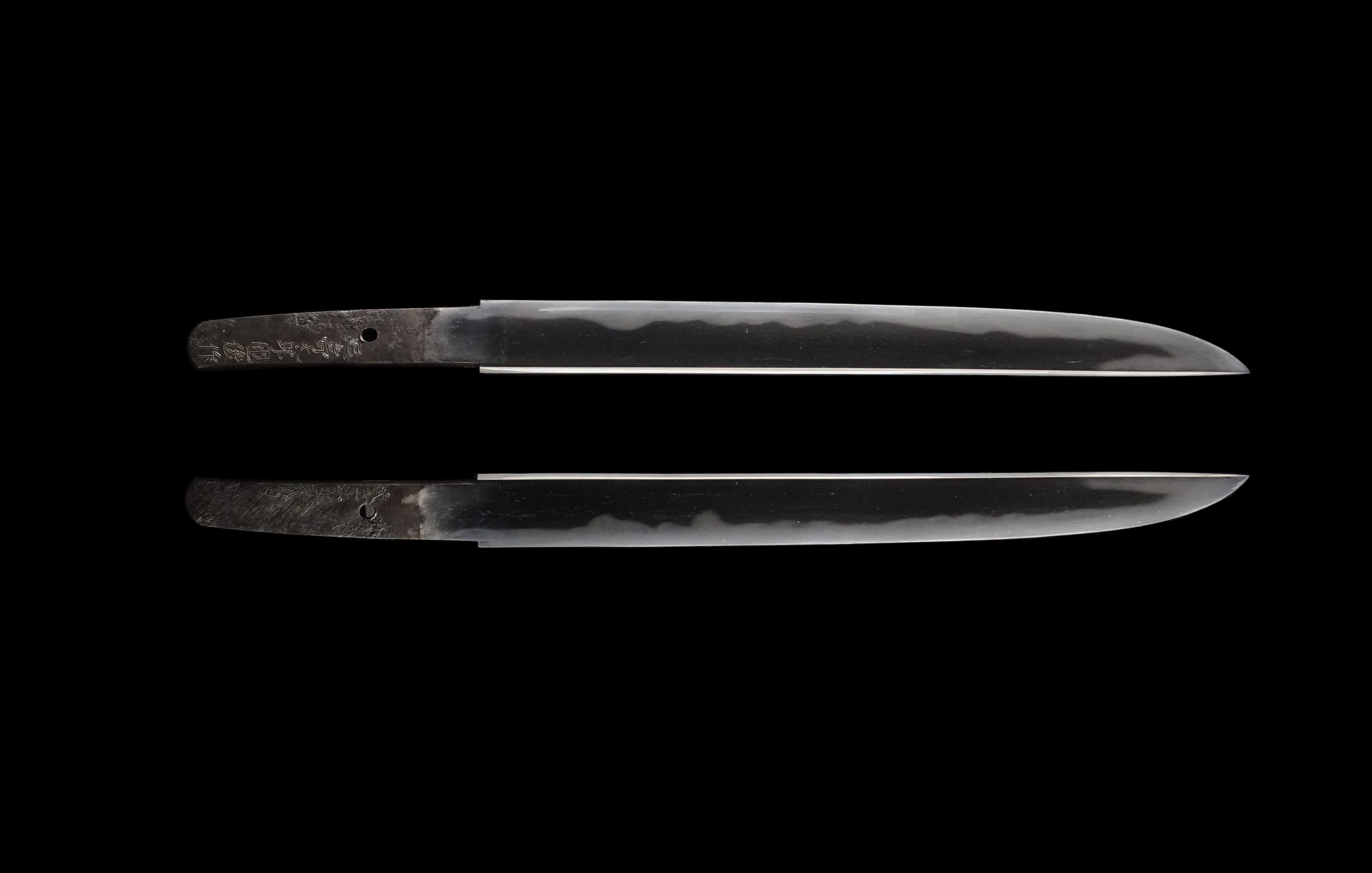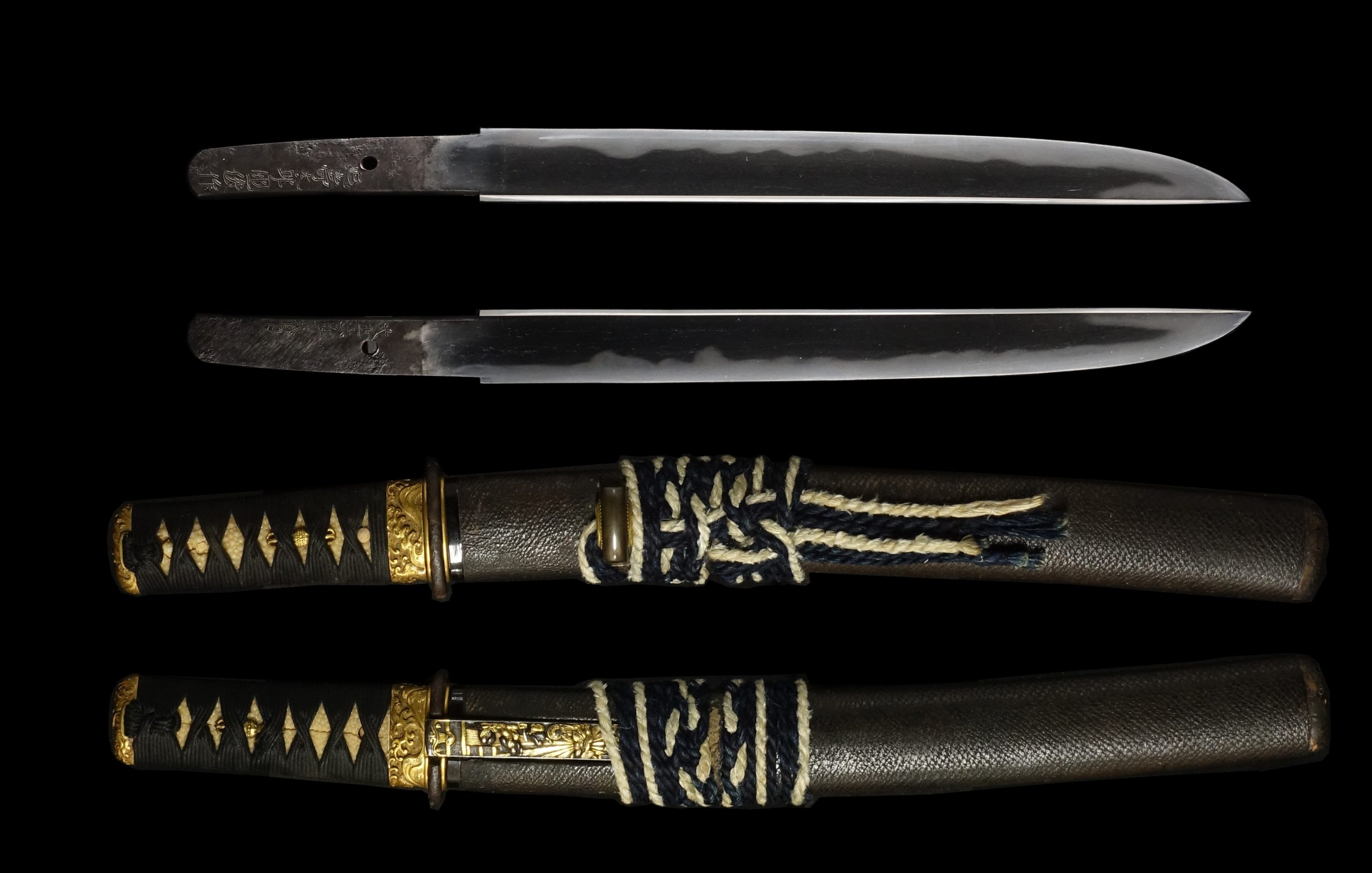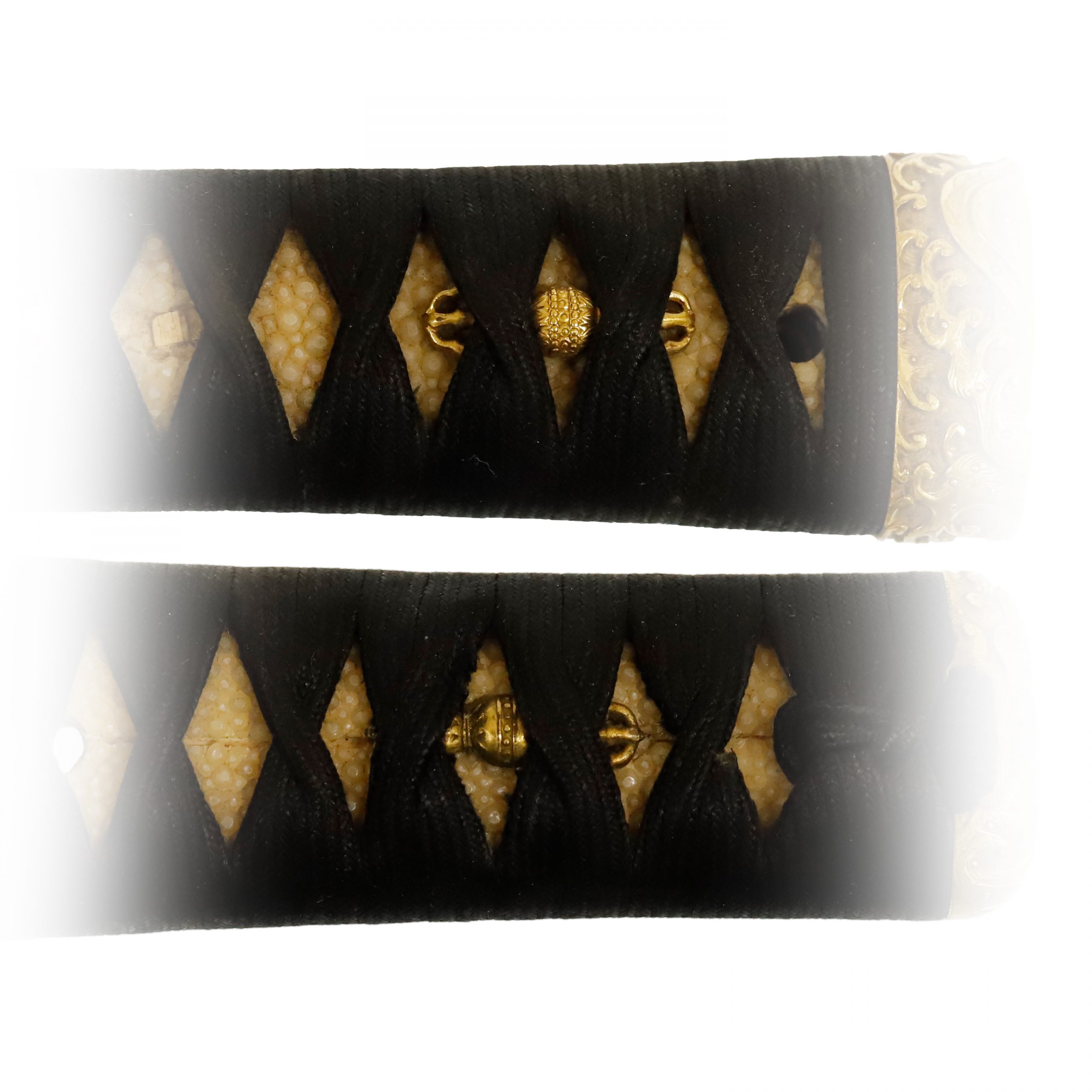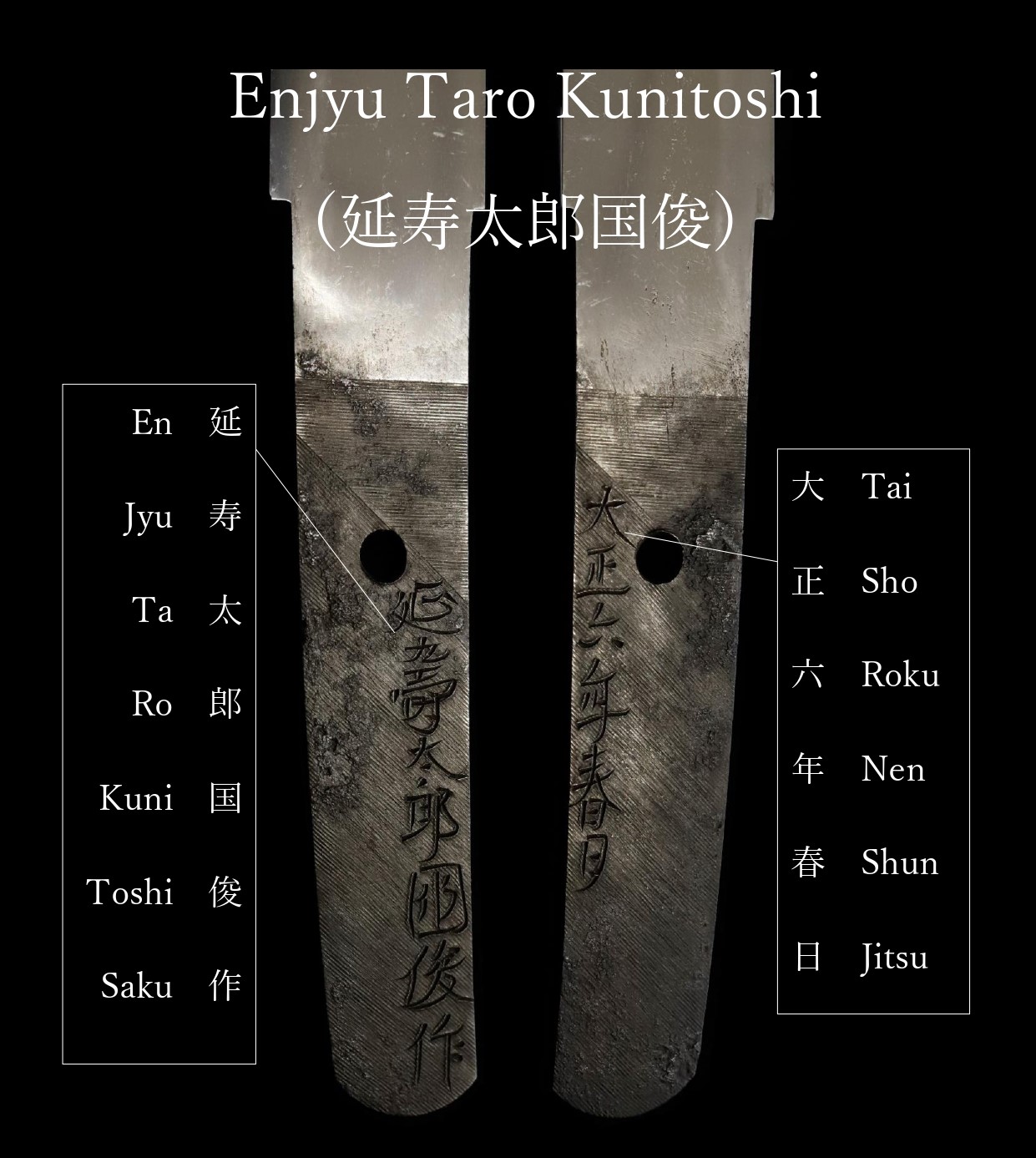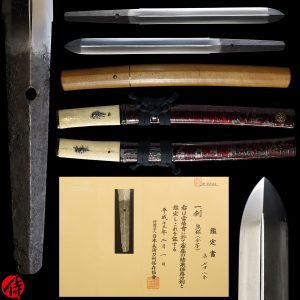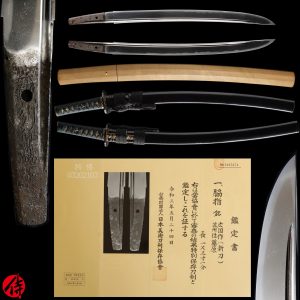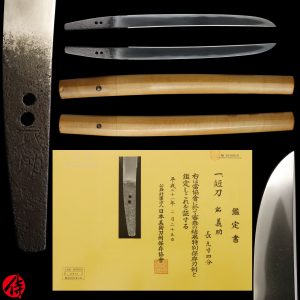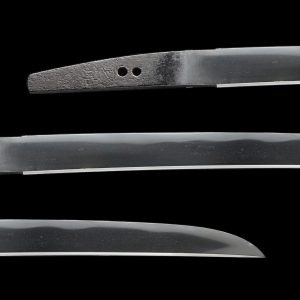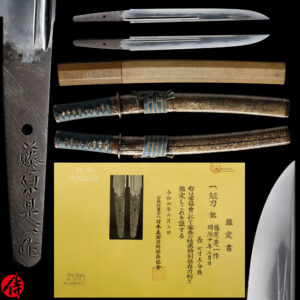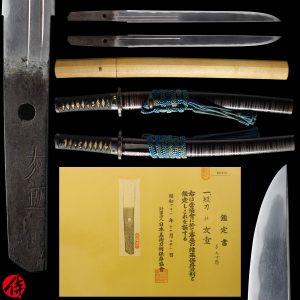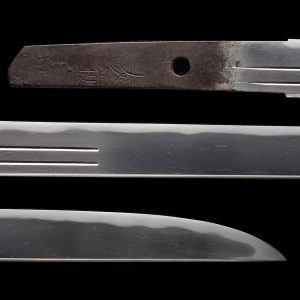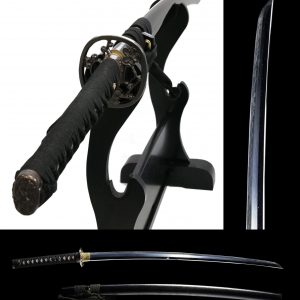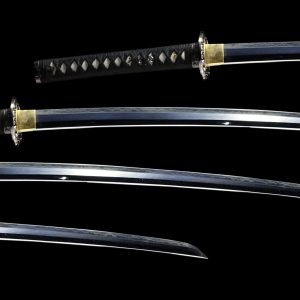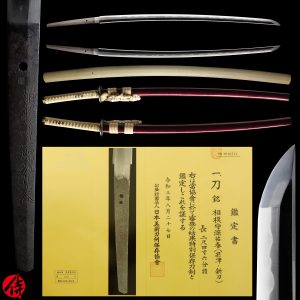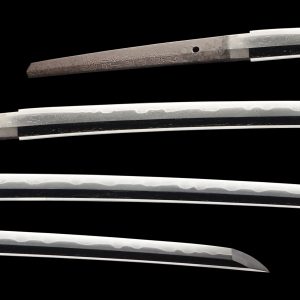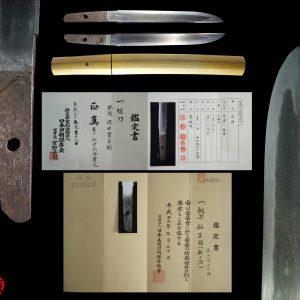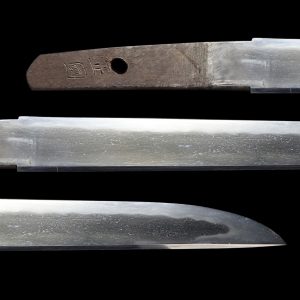Modern Japanese Sword Gendaito Tanto Signed by Kunitoshi with NBTHK Hozon Certificate
【Description】
This blade was signed by Enjyu Taro Kunitoshi (延寿太郎国俊) in the 6th year of the Taisho era (1917). He called himself as the 17th-gen Enjyu Kunimura (延寿国村). He mainly resided in Higo province (today’s Kumamoto prefecture) and also forged in Osaka city.
Who is Enjyu Kunimura?
Enjyu(延寿) is the prestigious school’s name that flourished during the late Kamakura period-Nanbokucho period(Early-Late 14th century). Enjyu school was founded by Kunimura(国村), who is said to have been the grandson of Rai Kuniyuki from Yamashiro province(Today’s Kyoto prefecture).
Kunimura and his apprentices moved to Higo province(Today’s Kumamoto prefecture in Kyushu island) after being invited by the Kikuchi clan, who had an influential power in that region. It is said that the 10th head of the Kikuchi clan, Kikuchi Takefusa(菊池武房), had to find skilled swordsmiths who could forge strong swords to combat the Mongolian army. Back then, Japan was targeted by the Mongolian emperor, and Kyushu island is where the battle was taking place twice(1274 and 1281). To prepare for the second attack from the Mongols, Kikuchi Takefusa brought Kunimura and his apprentices from Kyoto. Since then, Kunimura and his sons served as Okakaekaji for this clan, exclusively forging swords for the Kikuchi clan, which ruled the Higo province back then. All the swordsmiths from Enjyu school used the letter “国” (Kuni) for their maker’s name.
The descendant of this school founded the famous sword school named Dotanuki(同田貫). And there are descendants of the Enjyu school’s swordsmiths throughout the Edo period. That means Enjyu school had over 500 years of its history. Enjyu Kunitoshi was also the one that kept the tradition of the sword-forging.
The name “Enjyu” is written as 延寿 in Japanese. If you translate the word literally, it means extending life span, which was construed as good luck among feudal lords. Therefore, the swords were presented among Samurai as good gifts back then.
This blade is appraised as a Hozon Token(保存刀剣) issued by NBTHK(Nihon Bijutsu Touken Hozon Kyokai:日本美術刀剣保存協会). This authentication paper was only given to authentic Japanese swords, well preserved with artistic value.
【Blade】
Cutting Edge Length(Nagasa): 28.1 cm( 11.0 inches)
Curvature(Sori): cm(inches)

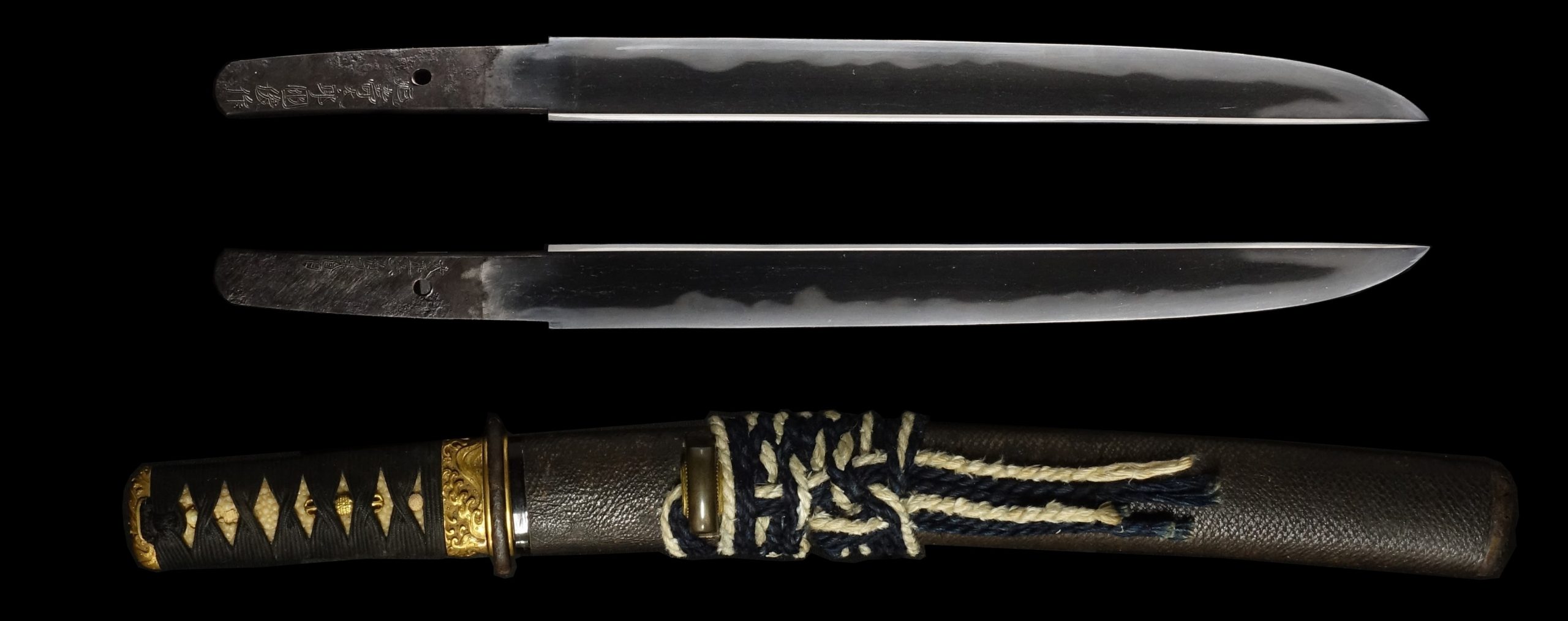
Hamon:
The crystalline structure which forms along the cutting edge of a blade as a result of the hardening process
Jimon(Jihada):
visible steel surface pattern created by folding and hammering during forging process
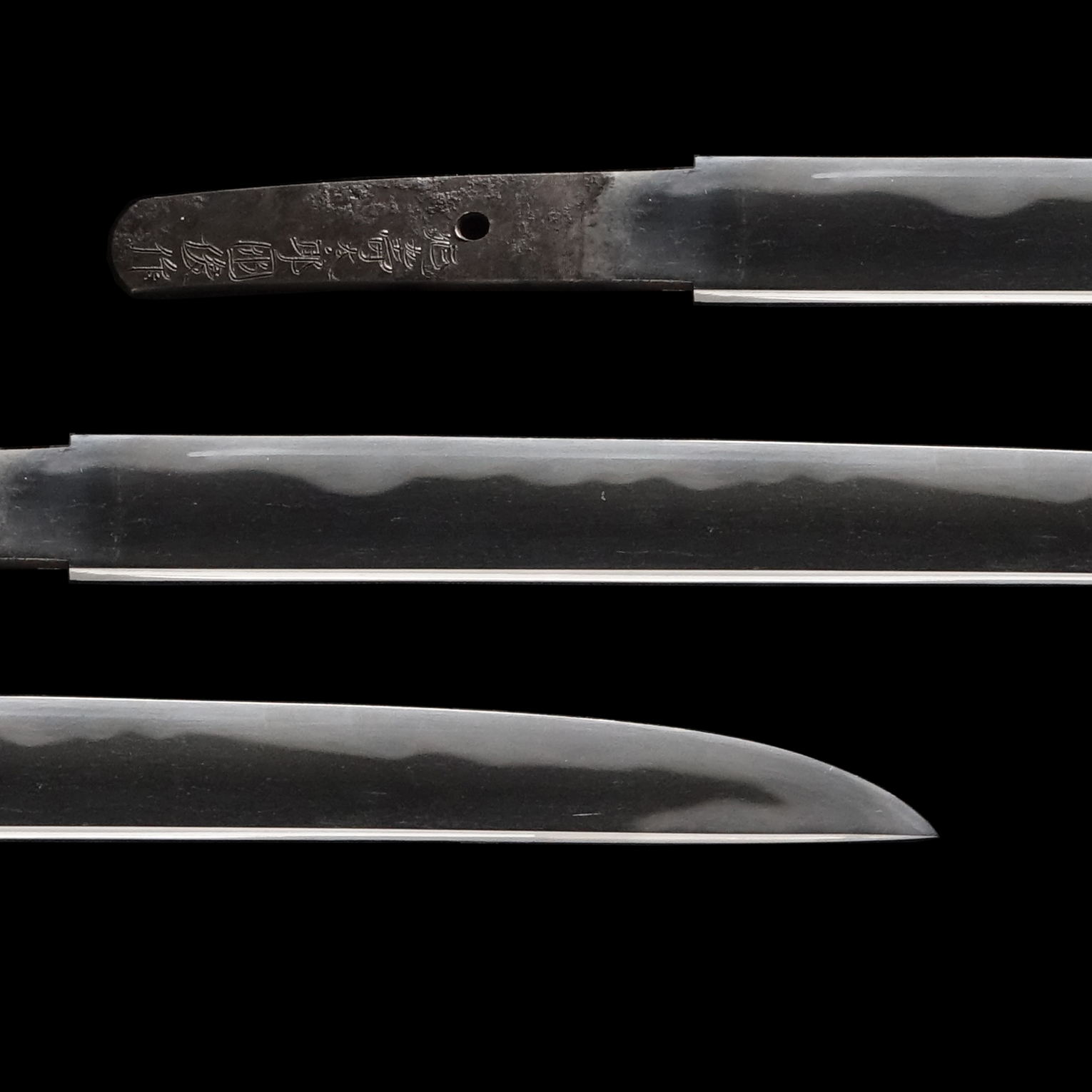
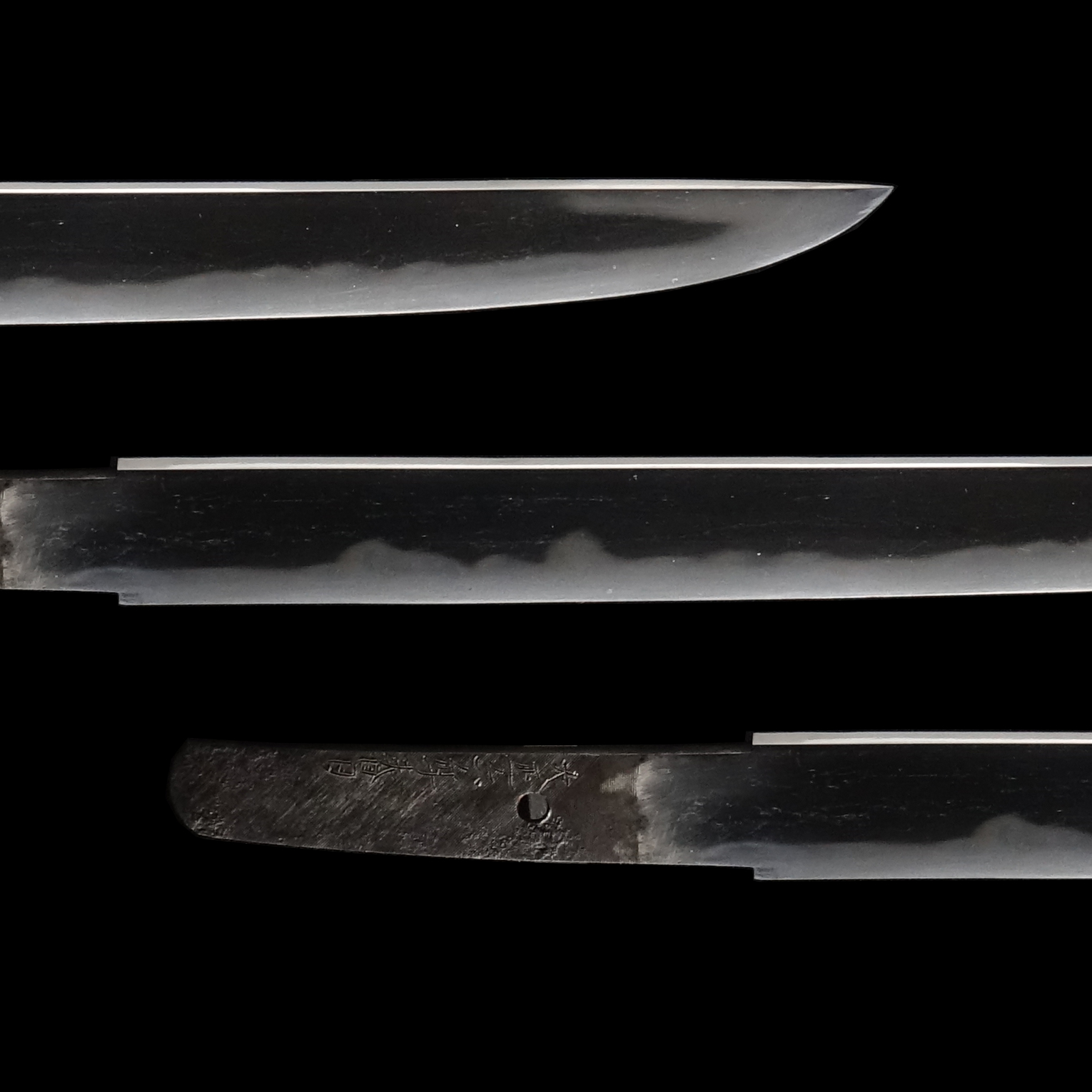
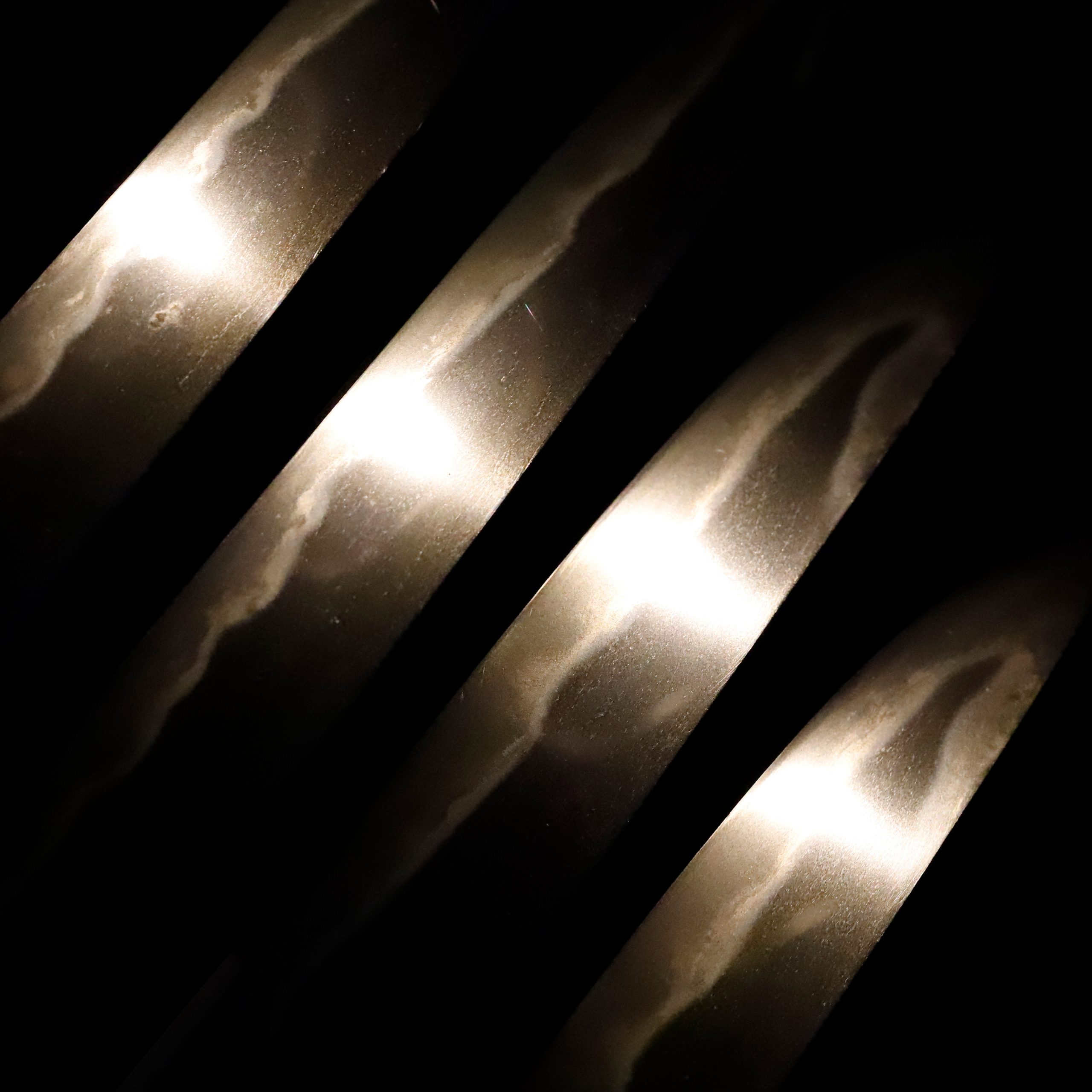

Nakago:Nakago is the tang of the Japanese sword.

Koshirae: Koshirae is the mounting of the Japanese sword. There are several parts that consist of Koshirae such as Saya(Scabbard), Tsuka(Handle), Tsuba(Handguard).
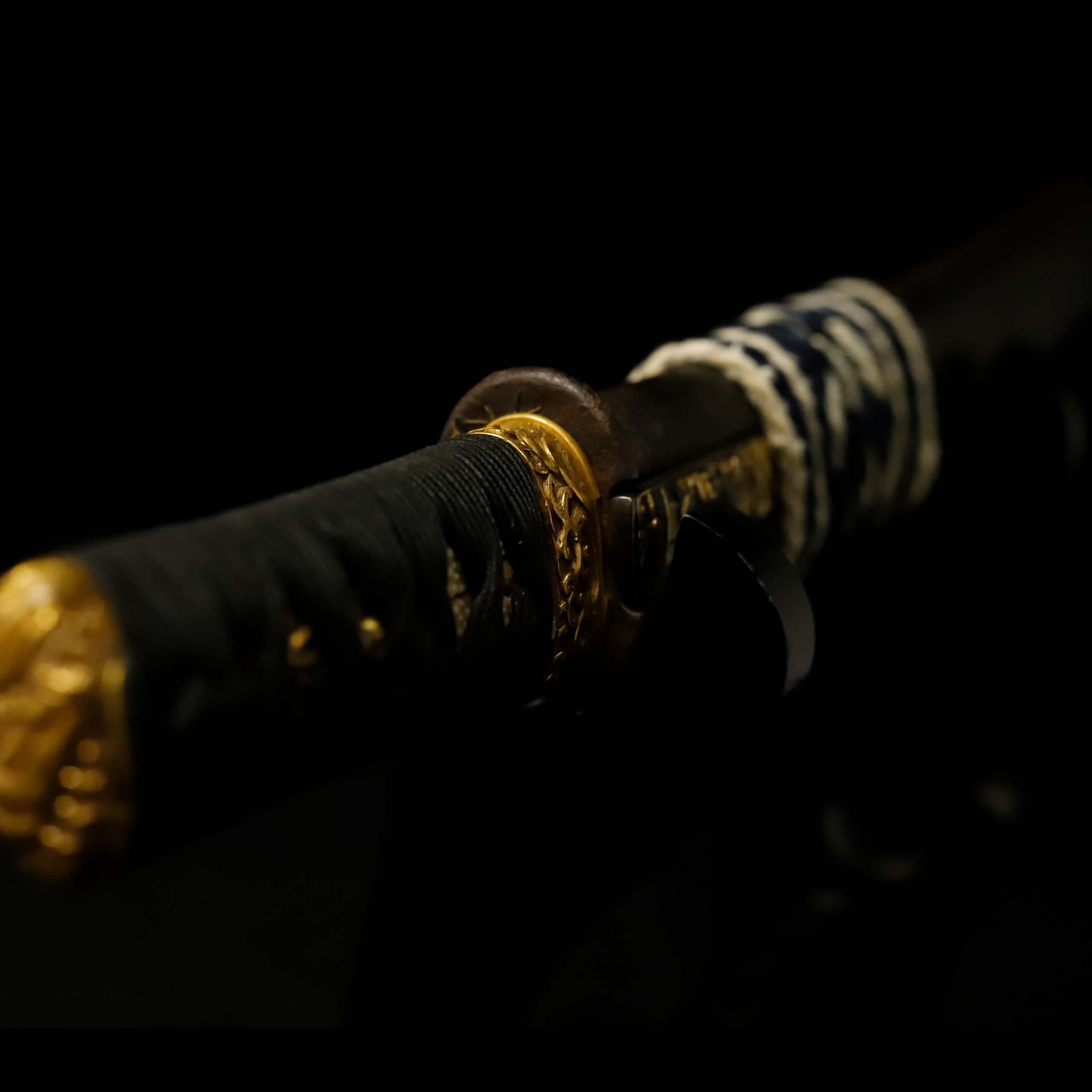
Fuchi-Kashira:A pair of matching sword fittings that cover the upper and bottom parts of its sword hilt.
This Fuchi Kashira has an ornamental look thanks to its gorgeous design and golden coloring. The wave pattern is carefully engraved and depicts dynamic scenery in the sea. As waves’ movements continue endlessly, the wave pattern represents eternity, immortality, longevity, birth, etcetera. Also, since tides repeatedly change the shape and terrain of rocks, some people hoped for a strong will by using this motif. People used this pattern wishing for an indomitable spirit to rechallenge time and time without giving up. Thanks to its dynamic design, this motif has been used, especially for men’s Kimono (traditional Japanese costume). We imagine many Samurais loved this energetic pattern.

Tsuka and Menuki:Tsuka is the handle of the Japanese sword and Menuki is its decoration.
This Menuki’s motif is the San-Kosho (三鈷杵). It is a type of Kongou-Sho (金剛杵), one of the esoteric Buddhist tools. The San-Kosho has three edges for each side. There is a handle in the center, and the sharp part is the blade of a spear. The name varies depending on the number of blades. Since this Kongou-Sho has three blades for each side, this Menuki’s motif is categorized as the San-Kosho (三 means three in Japanese). It is said that some Samurais have enjoyed incorporating religious motifs for sword mountings. We guess one of the former owners of this sword might have been a believer in esoteric Buddhism.
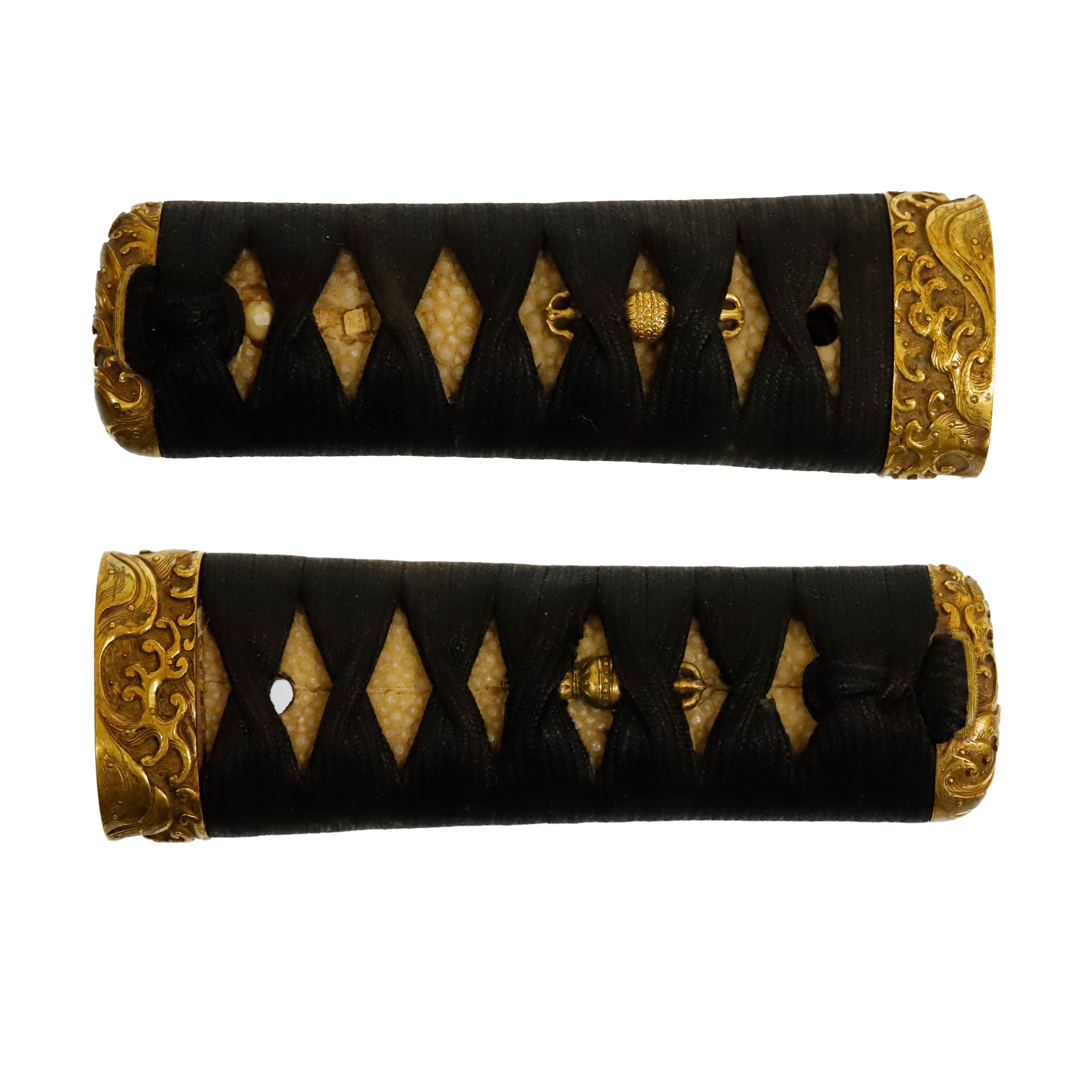
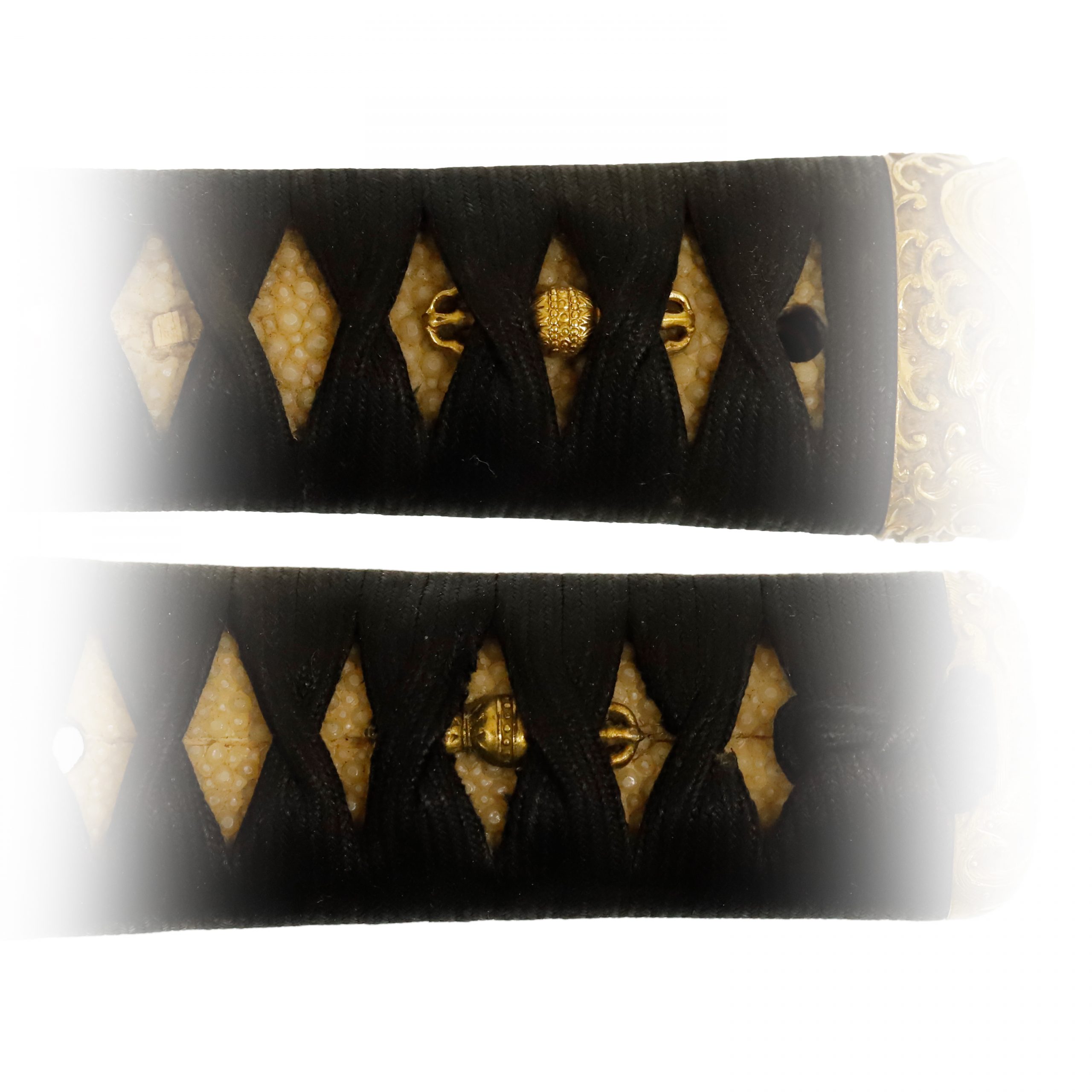
Tsuba and Habaki:Tsuba is the handguard for the Japanese Sword and Habaki is the equipment to make the blade not touch its scabbard inside. It prevents the blade from getting rusty and chipped.
Although this Tsuba is small, it is a graceful work with carefully carved motifs such as a bird and a plant. This bird is probably a Shirasagi (白鷺, egret). Egret is a popular motif because of its beautiful white feathers and elegant appearance. The grass that grows on the ground and the flying heron in the sky make a geographical contrast. This Tsuba depicts one of the magnificent scenery of nature on this tiny screen.
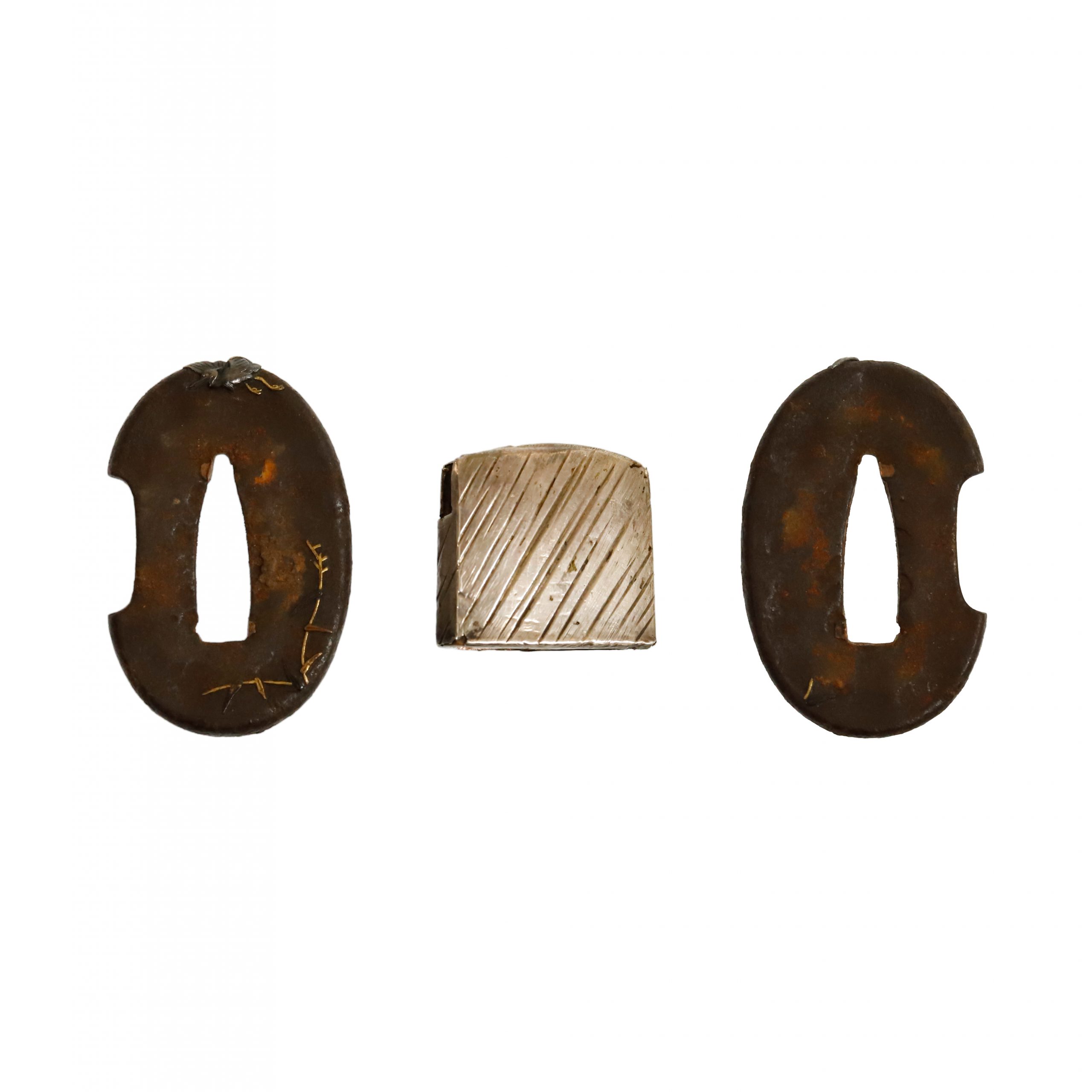
Saya:Saya is the scabbard for the Japanese sword.
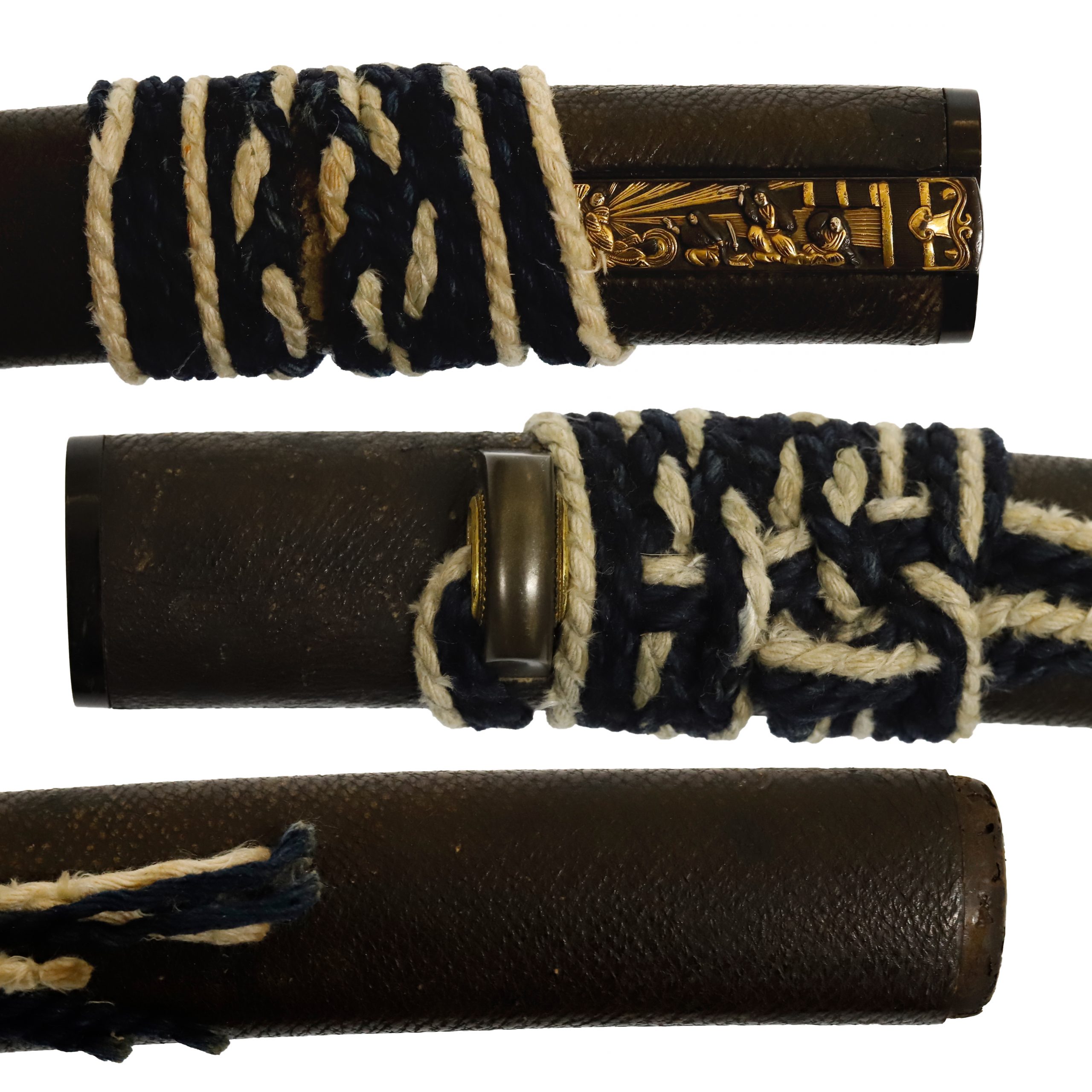
Kozuka:Kozuka is a small knife stored in Kozuka Hitsu(groove of the sheath of the Japanese sword).
A Kogatana (小刀, small knife) is stored in the Kozuka. It depicts a haloed woman (probably a goddess) and women who worship her. It is challenging to judge who she is; we could list several possibilities. As Menuki’s motif is related to a religion, we would guess that this Kozuka’s design is also probably related to a kind of faith. For example, there is a very famous female god: Amaterasu-Ōmikami (天照大神/天照大御神). She is the goddess who controls the sun, and many people still worship her today.


Authentication Paper:NBTHK Hozon Certificate for the blade (No.331498)
NBTHK, also known as Nihon Bijutsu Touken Hozon Kyokai (the Society for the Preservation of the Japan Art Sword), is one of the oldest Japanese sword appraising organizations in modern-day Japan. They authenticated the blade on Feb 25th in the 5th year of Heisei (1993). They appraised it as Hozon Touken, the blade worth preserving for Japanese society. The purchaser will receive this original certificate as well. We can also translate what is written into English and make a PDF file for your record if you request.
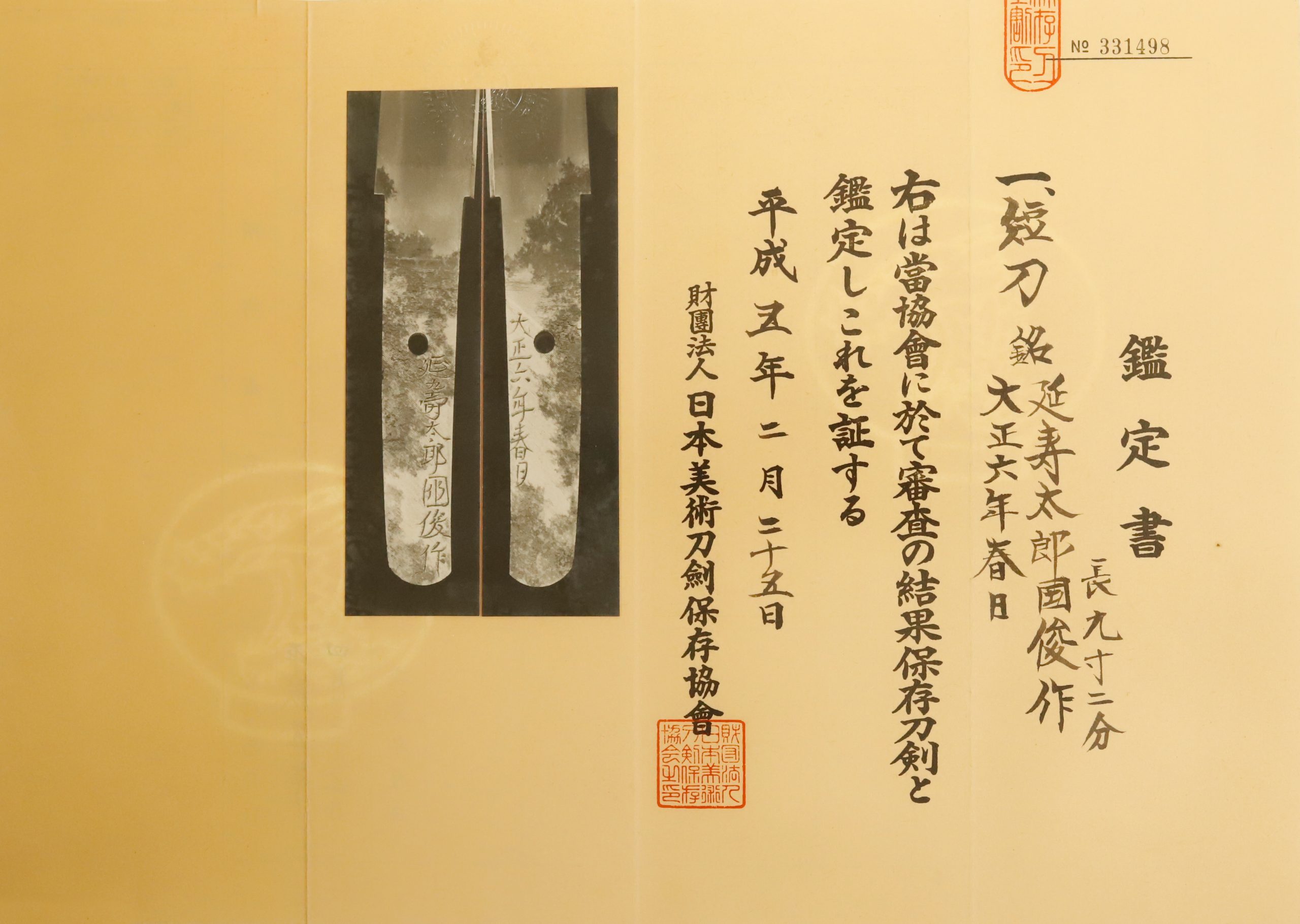
Registration Number : Tokyo 255286
The Board of Education in Tokyo prefecture issued a registration paper for this sword . It is called Jyu Token Rui Torokusho(銃刀剣類登録証). Bunkacho(The Agency for Cultural Affairs) acknowledges a Japanese sword with this paper as a work of art.
The sword needs to be traditionally hand-forged and made of Tamahagane carbon steel to be registered in the system. With this paper, its owner in Japan can legally own an authentic Japanese sword. Based on this registration number, we will apply for its export permit.
This paper will need to be returned to the board of education when the sword is being shipped abroad, but you can receive a copy of it. An English translation of this registration paper is available on request.
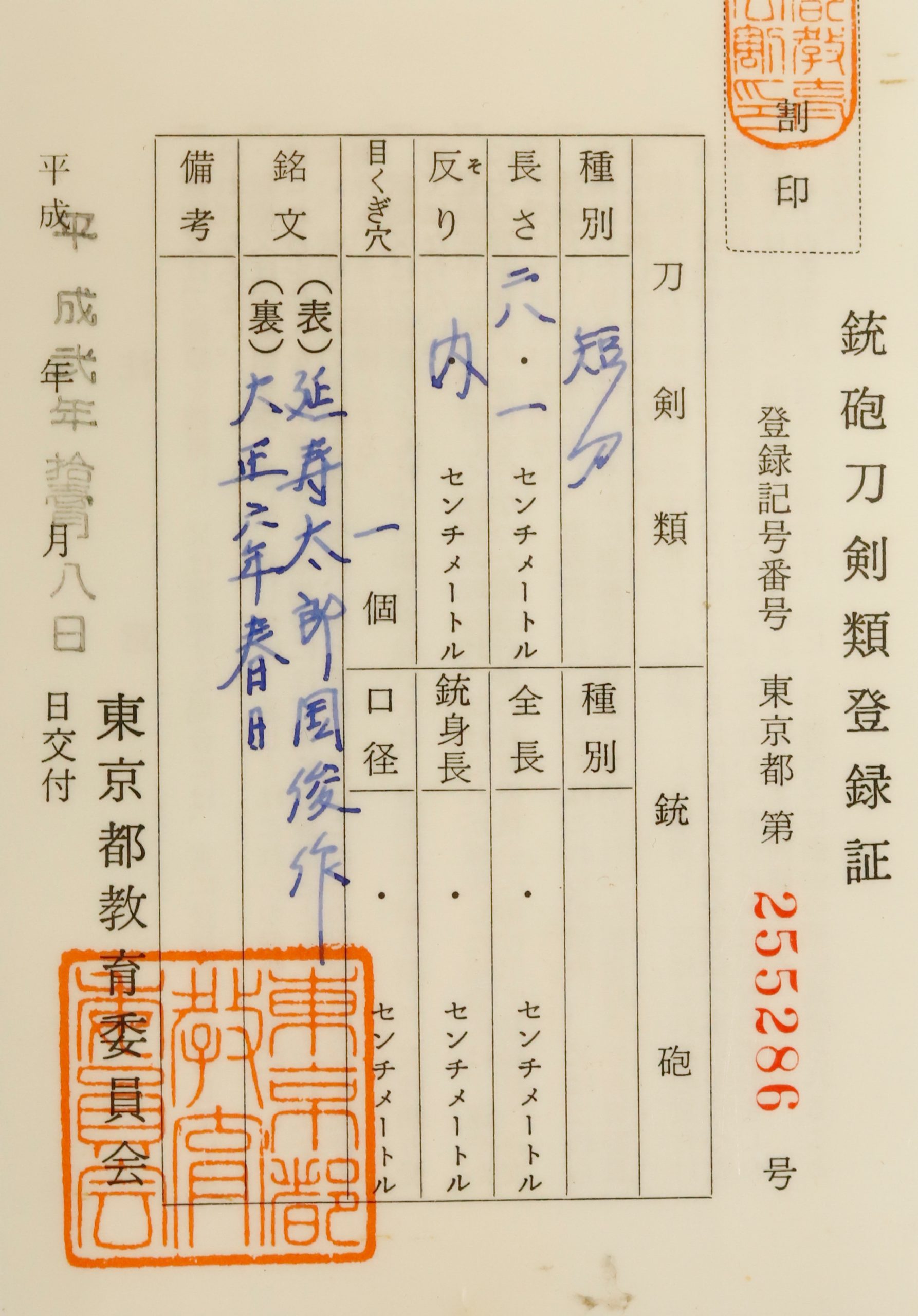
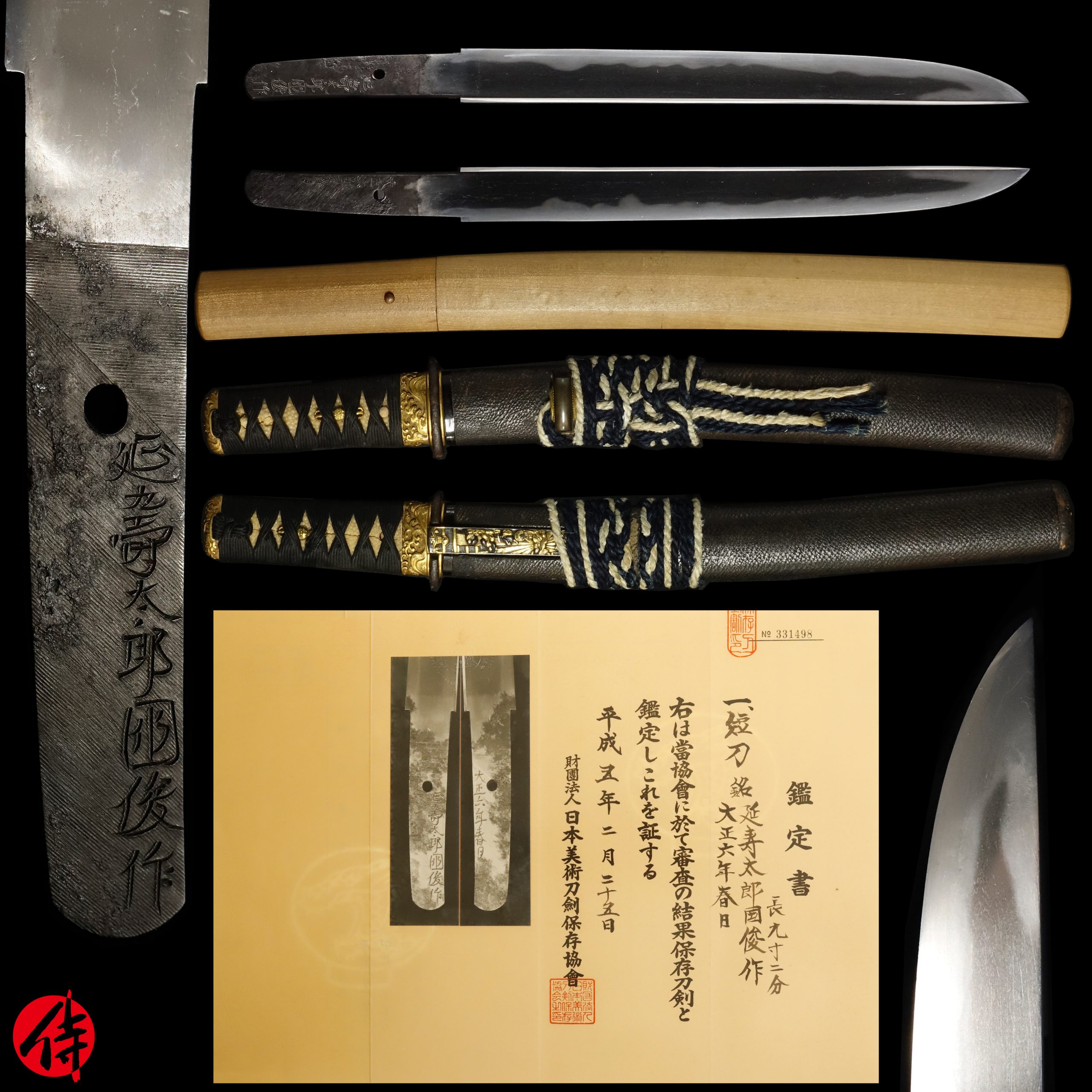
—————————————————————–
【About us】
Samurai Museum is located in Tokyo, Japan, exhibiting antique artifacts related to the Samurai history. Samurai Museum Shop is the place for those who are interested in Japanese culture and craftsmanship. We deal with antique Samurai swords/armor, traditional crafts made in Japan and so on.
【Japanese Sword& Export Process】
The Japanese swords we deal with are hand-forged edged swords made in Japan. It was made from the traditional carbon steel called TAMAHAGANE(玉鋼). Samurai Museum is familiar with the proper legal procedure for an antique/ authentic Japanese sword to be exported from Japan. We have sent more than 300 Japanese swords to amazing owners who appreciate its historical value.
Each Japanese sword is registered under the Agency for Cultural Affairs and the Board of Education in Japan.They issue a registration paper for each Japanese sword for its owner in Japan to legally possess it. The Japanese sword with its registration paper means it was traditionally hand-forged in Japan.
To legally export the sword from Japan to other countries, we will have to apply for its permit to the Agency for Cultural Affairs(Bunkacho) and return the original registration paper to the Board of Education. It normally takes around 2-4 weeks to receive this permit after submitting required documents. And we would like you to expect at least 1-1.5 months for your order to arrive at your given address after you ordered. For more detailed info, please click here.
It is allowed for residents in Japan to own authentic Japanese swords without a special license as long as they come with registration papers. Please feel free to contact us if you are a resident of Japan, whether temporarily or permanently. We will also assist you when you leave Japan and need to obtain the export permit.
【Payment Method】
We accept payment through Stripe (Credit card), PayPal, Apple Pay or ChromePay, all of which are secure payment methods. Also, you don’t need to make an account on Stripe for the checkout. If you prefer other payment method, please contact us. After confirming your payment, we will apply for an export permit. You may either pay in JPY, USD, AUD, CAD,EUR or GBP. The price is set in Japanese Yen. Prices in other currencies are automatically calculated based on the latest exchange rate.

* If the amount is above 1 million JPY, Stripe or wire transfer will be the only options for payment.
【Shipping】
We have shipped authentic Japanese swords to the USA, Canada, Mexico, UK, Germany, Switzerland, France, Hong Kong and Australia. If you don’t live in these countries and like to order, please contact us first before making a purchase. We offer Free International Shipping as long as we can send antique Japanese swords by either EMS or FedEx(Canada).
We normally ship by EMS(Express Mail Service) provided by Japan Post. When we receive an order from the Canada we will use FedEx instead as EMS temporarily stops shipping from Japan to those countries due to COVID-19.
We will send you a tracking number for your order as soon as we hand it to the post office/FedEx. We will put 100 % insurance on the shipping document without any extra charge. Based on the total amount, there might be a duty tax or other fee for you to pay, depending on the countries. We use package cushioning to protect the item and put it in a PVC pipe, which is one of the most secure packages because of its durability.
It will normally takes 5-14 days for the item to arrive at your given address after we dispatch it. Time of delivery is estimated as accurately as possible by the carrier but does not take into account any delays beyond our control such as by inclement weather, post office holiday seasons.
* If you live in Australia and like to purchase an authentic Japanese sword, please click here to know the detail.
*Please keep in mind that due to the spread of COVID-19, there might be delays in shipping. If you like to know the detail about shipping, please feel free to ask us.

【How to make sure the condition】
Please keep in mind that what you are going to purchase is an antique item. We uploaded high resolution photos for you to check its condition thoroughly. If you like to see more photos with different angles, please feel free to contact us. We will be happy to send them to you so that you can make informed decision. It is essential for us to know that you are happy with your choice of a sword. and we are prepared to use the best of our ability to serve you.
【The Art of Nihonto(Japanese Sword)】
Samurai’s history is a profound, eloquent legacy of ancient Japanese warriors in which millions of people worldwide are being fascinated. If you like to find out the art of Nihonto, please click here.
【A Guide to Japanese Sword Maintenance】
After acquiring an genuine Japanese sword, it is also important to know how to take good care of it. Here is the special video for you. Mr. Paul Martin, Japanese sword expert, shows you how to give proper maintenance to your sword. By mastering how to clean the Japanese sword, its aesthetic beauty will last forever.
When you purchase a Japanese sword from us, you can get a Free Japanese sword maintenance kit. It comes with four tools(Choji Oil, Uchiko Whetstone Powder, Peg remover, Oil Applicator). By watching the video instruction above , you can enjoy learning how to maintain your Japanese sword while appreciating it. If you have any difficulty assembling the sword or cleaning the blade, you can feel free to contact us.


